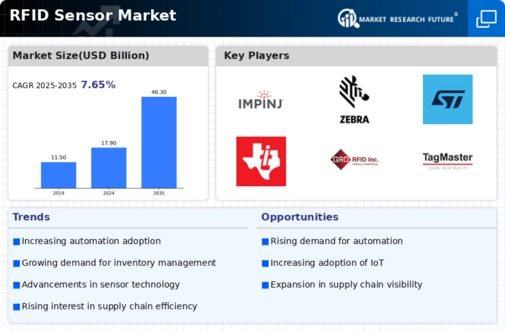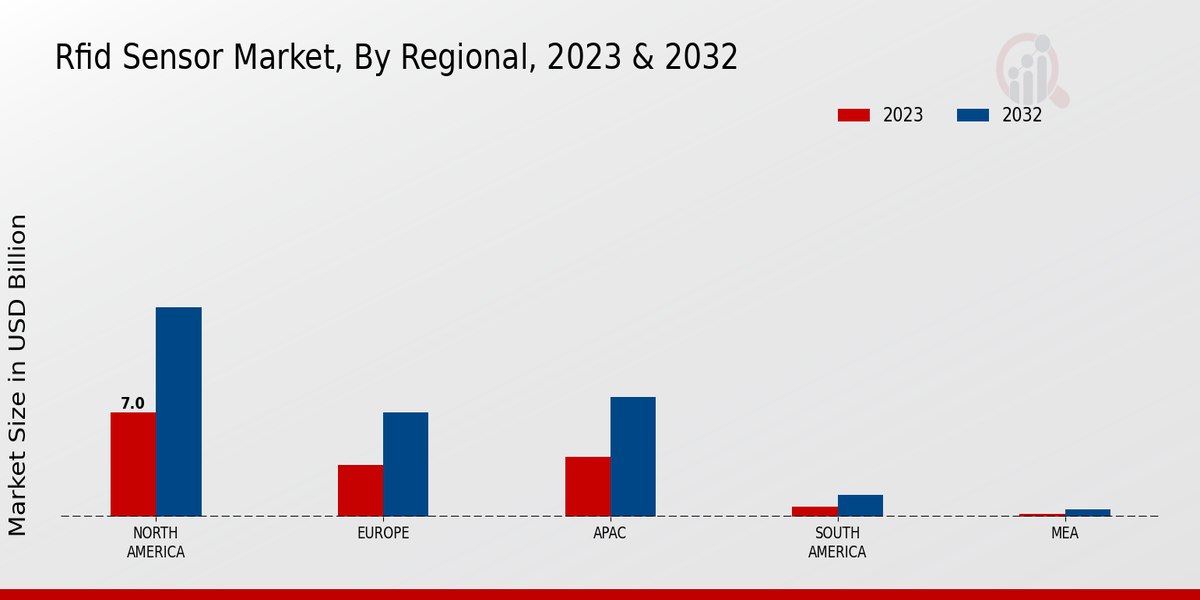Market Growth Projections
The Global RFID Sensor Market Industry is projected to experience substantial growth over the coming years. With a market value of 17.9 USD Billion anticipated in 2024, the industry is expected to expand significantly, reaching an estimated 40.3 USD Billion by 2035. This growth trajectory indicates a compound annual growth rate of 7.65% from 2025 to 2035, reflecting the increasing adoption of RFID technology across various sectors. The expansion of the market is driven by factors such as automation, supply chain optimization, and technological advancements, positioning RFID sensors as a critical component in modern industrial applications.
Growing Demand for Automation
The Global RFID Sensor Market Industry experiences a notable surge in demand for automation across various sectors, including manufacturing, logistics, and retail. As industries increasingly adopt automated solutions to enhance efficiency and reduce operational costs, RFID sensors play a pivotal role in streamlining processes. For instance, in logistics, RFID technology enables real-time tracking of inventory, thereby minimizing errors and improving supply chain visibility. This trend is expected to contribute significantly to the market's growth, with projections indicating a market value of 17.9 USD Billion in 2024, reflecting the industry's shift towards automation.
Enhanced Supply Chain Management
The Global RFID Sensor Market Industry benefits from the growing emphasis on supply chain management optimization. Companies are increasingly leveraging RFID sensors to gain real-time insights into their inventory and asset management. This technology facilitates better tracking of goods throughout the supply chain, reducing losses and improving overall efficiency. For example, retailers utilizing RFID technology can achieve inventory accuracy rates exceeding 95 percent, which directly impacts profitability. As organizations recognize the value of enhanced supply chain visibility, the market is poised for growth, with a projected value of 40.3 USD Billion by 2035.
Increasing Focus on Asset Tracking
The Global RFID Sensor Market Industry sees a rising focus on asset tracking solutions, particularly in sectors such as healthcare, manufacturing, and transportation. Organizations are increasingly adopting RFID technology to monitor the location and status of critical assets, thereby reducing losses and improving operational efficiency. For instance, hospitals utilizing RFID sensors for tracking medical equipment report a significant reduction in equipment loss and improved patient care. This trend underscores the growing recognition of RFID technology as a vital tool for effective asset management, contributing to the market's robust growth trajectory.
Regulatory Compliance and Safety Standards
The Global RFID Sensor Market Industry is influenced by the increasing need for regulatory compliance and safety standards across various industries. Governments and regulatory bodies are implementing stringent guidelines that necessitate accurate tracking and reporting of goods, particularly in sectors such as pharmaceuticals and food safety. RFID sensors facilitate compliance by providing reliable data on product provenance and handling. For example, the pharmaceutical industry utilizes RFID technology to ensure traceability of drugs, thereby enhancing patient safety. This regulatory landscape is likely to drive demand for RFID solutions, further propelling market growth.
Technological Advancements in RFID Technology
The Global RFID Sensor Market Industry is propelled by continuous technological advancements in RFID technology. Innovations such as the development of passive RFID tags with improved read ranges and enhanced data storage capabilities are driving adoption across various sectors. Furthermore, the integration of RFID with IoT devices allows for more sophisticated data analytics and real-time monitoring. These advancements not only improve the functionality of RFID systems but also expand their applications in areas such as healthcare and smart cities. As a result, the market is expected to witness a compound annual growth rate of 7.65% from 2025 to 2035.















